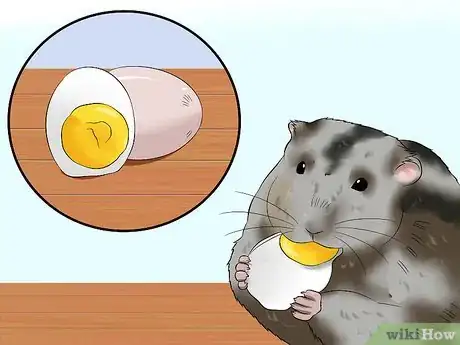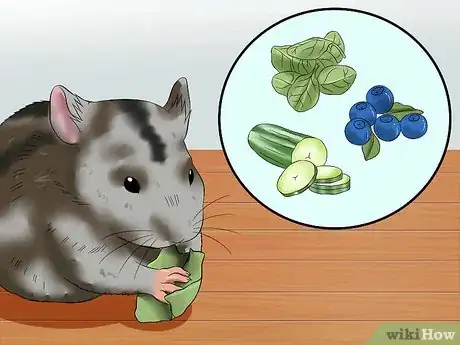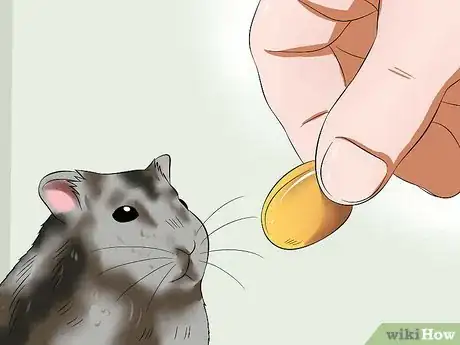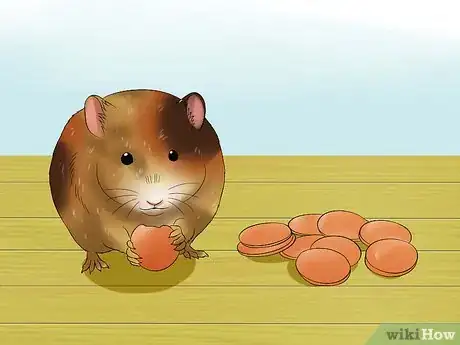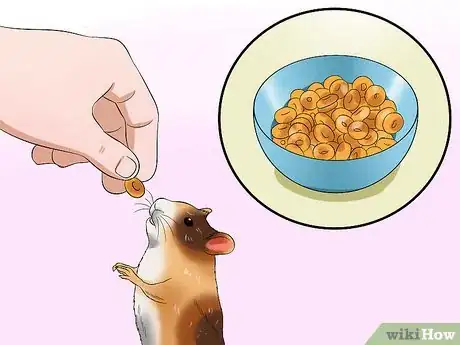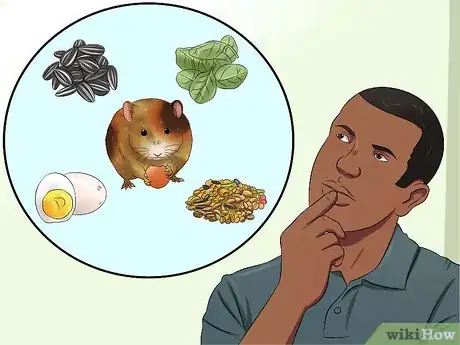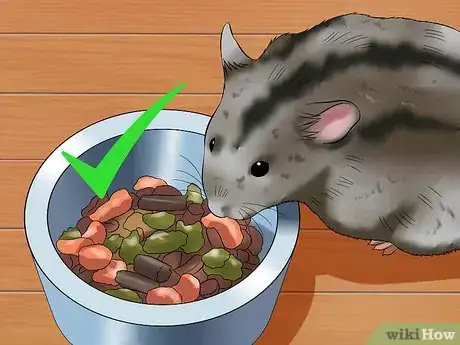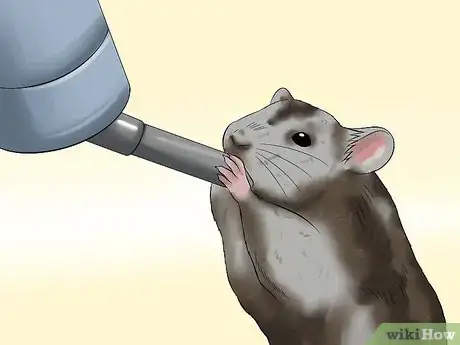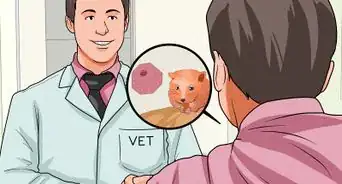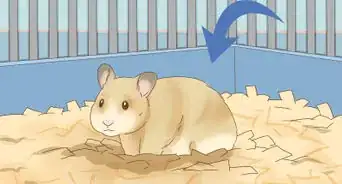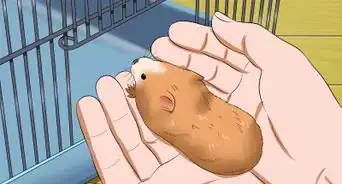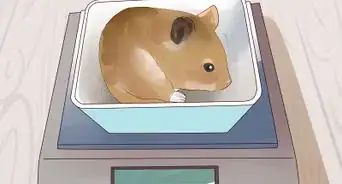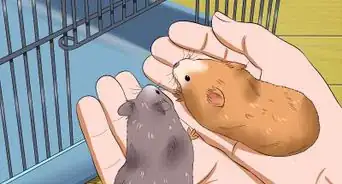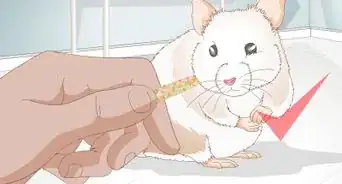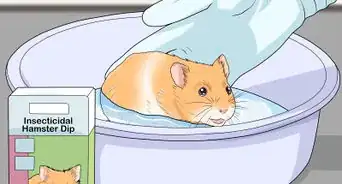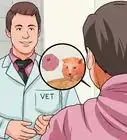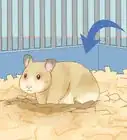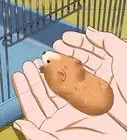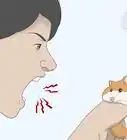This article was co-authored by Pippa Elliott, MRCVS. Dr. Elliott, BVMS, MRCVS is a veterinarian with over 30 years of experience in veterinary surgery and companion animal practice. She graduated from the University of Glasgow in 1987 with a degree in veterinary medicine and surgery. She has worked at the same animal clinic in her hometown for over 20 years.
wikiHow marks an article as reader-approved once it receives enough positive feedback. In this case, several readers have written to tell us that this article was helpful to them, earning it our reader-approved status.
This article has been viewed 43,227 times.
If you're concerned about keeping pesticides and other harmful chemicals out of your hamster's diet, you may decide to try your hand at making your own organic hamster food. Fortunately, hamster food is simple to make and the ingredients are easy to obtain at most health food stores. When making your own hamster food, the most important thing is to understand the elements of a balanced hamster diet, and then build your hamster's menu based on available, organic options in your area. This guide will help you understand hamster nutritional needs and give you ideas for a balanced menu. Keep in mind that this guide assumes that you are feeding a Syrian hamster or other large, common variety; if you are feeding a smaller variety, you should include a majority of bird seeds instead of cereal and less fruit.
Steps
Planning a Balanced, Organic Menu
-
1Make the bulk of her diet carbohydrates and fats. She uses these for energy and to stay warm. While this is what she will eat most of the time, don't overfeed her on just this category or she can become overweight and ill.[1]
- Organic bird seed, unsalted raw sunflower seeds, dried corn, unsalted nuts, unsalted and unsweetened nut butters, cooked potatoes, and grains of all kinds are great sources of carbs and fat for her diet.[2]
-
2Serve up protein. Your hamster requires protein from a natural source, and luckily you can find most of these options in organic, pesticide-free varieties in local stores. Hamsters need about a teaspoon of protein-rich foods two or three times a week.
- You can feed your hamster organic chicken, turkey, or eggs to provide the needed protein for her diet. Cook it thoroughly but do not season it with salt or pepper. Do not serve it hot as it will burn the hamster.
- You can also serve your hamster live insects such as mealworms or crickets. You may have trouble finding organic varieties in pet stores, but you can find them from online vendors in select countries.
- Other great sources of protein for your hamster also happen to be good sources of carbohydrates, like beans, barley, peas, nuts, oats, or wheat.[3]
Advertisement -
3Be sure you offer a variety. In order for your pet to get the right blend of vitamins and minerals, be sure to offer fruits and vegetables in many colors and a variety of proteins and grains.[4]
- Keep track of what she eats and what she rejects. In some cases, if she rejects a particular food it is because she has enough of that particular nutrient in her diet and doesn't need it. [5] If you find that your hamster rejects all of a particular category of food (for instance, all sources of calcium), you might need to invest in a hamster health supplement to prevent deficiencies. These are available at large pet stores or online.
Offering Healthy, Organic Treats
-
1Offer treats in addition to a healthy diet. Think of treats as foods that you don't offer daily but that still play a vital role in your hamster's healthy nutrition.
- Never offer any sugary or salted foods or processed human foods. These can't be digested properly by a small rodent and could be deadly.
-
2Give a small piece of vegetable or fruit daily. There are many organic produce options at your local grocery store that you can give to your pet. If you already eat an organic diet with your family, it is easy to buy a tiny bit more than you need and give a small piece to the hamster when you prepare dinner or lunch for your family every day. Throw away what she doesn't eat so that it doesn't go bad in her cage.
- Fruits like apple, banana, melon, or grapes are great choices, but you should not offer them too frequently because of the high sugar content. Every few days is plenty. More frequently, try pieces of vegetables like cucumber, corn on the cob, carrot, peas, celery, broccoli, cauliflower, or beansprouts.
- Don't offer citrus fruits like lemons, limes, or oranges, and don't offer onions, leeks, chives, or garlic. These types of food are too acidic and can cause stomach issues for small rodents. You should also never offer raw potato, aubergine, or avocado, which are toxic to hamsters.
-
3Offer hard dog or cat biscuits occasionally. Hamster teeth, like other rodents, grow continually and have to be filed down in order to not overgrow. Hard biscuits made for dogs or cats are perfect for hamsters to keep those teeth from getting too long.[6]
- Dog and cat biscuits are both available in organic varieties online, or try your hand at making your own: Combine two cups of whole wheat flour, a cup of rolled oats, a tablespoon of dried parsley, and half a cup of powdered milk in a mixing bowl. Add a cup of unsweetened peanut butter, two large eggs, and half a cup of water, and stir to combine. Shape the dough into dog-biscuit sized logs and bake for about fifty minutes at 300 degrees Fahrenheit.[7]
- Experiment by adding different types of seed or nut butters and other healthy additions like flax seed, millet, or different types of whole grain flour.
-
4Try other treats. Your hamster may love some of your healthy foods like whole wheat organic bread, organic unsweetened cereal, organic scrambled eggs, and organic uncooked pasta.[8]
- Just remember not to serve any foods to your hamster with added salt or hot from the oven!
Understanding Hamster Nutritional Needs
-
1Understand natural hamster eating habits. In the wild, hamsters are omnivores, which means they eat both meat and vegetation regularly. They forage for food and eat a diet consisting of a variety of seeds, insects, and plants. If you want to make your own hamster food, you have to be sure that you include nutrients from all of these categories, as well as a balance of carbohydrates, fats, and other vital nutrients.
- The best way to ensure that your hamster is getting all the right nutrients is to serve a diet that varies every day and includes grains, seeds, herbs, vegetables, protein, nuts, and treats. You can create a hamster mix using organic ingredients, or you can simply offer a small amount from each category of foods every day.
- Be sure that your hamster's menu includes protein, carbohydrates and fats, vitamins, minerals, and water. The first four elements of a healthy diet will be discussed in more detail in the next step.
-
2Don't worry about overfeeding. For the most part, a hamster will not eat more than he needs to survive. Most eat about a tablespoon worth of food every day, so be sure to add a steady supply of fresh food to his cage daily.[9]
- Hamsters will also instinctively eat more of what they need and leave behind some of what they don't. If your hamster always ignores particular food, offer less of it and more of what he eats.[10]
-
3Keep fresh water in the cage. Water is a huge part of a hamster's diet, and a hamster with the healthiest organic diet will still become dehydrated and die if she doesn't have enough water. Don't neglect hydration in your pursuit of a healthy and organic diet.
- Keep a hamster water bottle full of clean water in the cage. Change the water every day.
- Don't offer other liquids. Hamsters will get plenty of fluids from fruits and veggies, but straight juice or milk is too strong and contains far too much sugar for a hamster.
Expert Q&A
-
QuestionHow do you make homemade hamster food?
 Melissa Nelson, DVM, PhDDr. Nelson is a Veterinarian who specializes in Companion and Large Animal Medicine in Minnesota, where she has over 18 years of experience as a veterinarian in a rural clinic. She received her Doctor of Veterinary Medicine from the University of Minnesota in 1998.
Melissa Nelson, DVM, PhDDr. Nelson is a Veterinarian who specializes in Companion and Large Animal Medicine in Minnesota, where she has over 18 years of experience as a veterinarian in a rural clinic. She received her Doctor of Veterinary Medicine from the University of Minnesota in 1998.
Veterinarian Its best to feed them a commercially prepared hamster food, but you can feed them tiny amounts of fruits and vegetables as treats for variety. Specifically, small amounts of apples, carrots, spinach, unsalted sunflower seeds, and lettuce.
Its best to feed them a commercially prepared hamster food, but you can feed them tiny amounts of fruits and vegetables as treats for variety. Specifically, small amounts of apples, carrots, spinach, unsalted sunflower seeds, and lettuce.
Warnings
- As with any other new food, watch your hamster closely after introducing new foods for a rare but serious allergic reaction, constipation, diarrhea, or other health concerns.⧼thumbs_response⧽
Things You'll Need
- Peanuts or other nuts
- Corn, cucumbers, and other vegetables
- Fresh fruit (but not citrus)
- Mealworms or crickets
- Oats and other grains
- Sunflower seeds
References
- ↑ http://hamsterific.com/hamster-illness-and-injury-guide/hamster-diet-and-nutrition/
- ↑ http://hamsterific.com/hamster-illness-and-injury-guide/hamster-diet-and-nutrition/
- ↑ http://hamsterific.com/hamster-illness-and-injury-guide/hamster-diet-and-nutrition/
- ↑ http://hamsterific.com/hamster-illness-and-injury-guide/hamster-diet-and-nutrition/
- ↑ http://hamsterific.com/hamster-illness-and-injury-guide/hamster-diet-and-nutrition/
- ↑ http://hamsterific.com/hamster-illness-and-injury-guide/hamster-diet-and-nutrition/
- ↑ http://www.kingarthurflour.com/blog/2010/12/13/puppy-love-our-biscuit-taste-test/
- ↑ https://pethamstercare.com/food-diet/
- ↑ http://hamsterific.com/hamster-illness-and-injury-guide/hamster-diet-and-nutrition/

